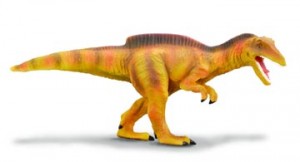Becklespinax – A Very English and Rare Theropod
Becklespinax – A Very English Theropod
One of the characteristics of the English is that they are supposed to be very reserved. This attribute can be ascribed to a number of theropod fossils found in England also, as fossils of these meat-eaters are very reluctant to show themselves. For example, a number of theropod fossils recovered from the Wealden Formation of southern England are extremely fragmentary and several genera of theropods are known from just scattered and isolated fossil fragments as a result. There are exceptions to this of course, for example, Neovenator (Allosauridae) from the Isle of Wight and Eustreptospondylus (Megalosauridae) from Oxfordshire. Scientists have been lucky enough to find almost complete specimens of these particular dinosaurs. However, for the majority of the theropod fossils associated with the United Kingdom fossil discoveries are very rare and what fossils we have are very incomplete.
Becklespinax
The dinosaur known as Becklespinax (B. altispinax) is typical. This particular theropod is known from just three articulated vertebrae (back bones), discovered in East Sussex in 1884. Some metatarsal and theropod teeth have been found in the same locality but whether or not these belonged to a Becklespinax or to other dinosaur genera is unknown.
Although, these fossils were first discovered 125 years ago, their exact taxonomic nature remains in doubt. Becklespinax was only finally pronounced to be a valid genus about 20 years ago, and the relationship between Becklespinax and other meat-eaters is still poorly understood.
From the fossils, scientists have been able to create an impression of what they think this dinosaur looked like. Typically about the size of Megalosaurus (M. bucklandi), with a length around 8 metres, the tall neural processes on the vertebrae indicate some sort of ridge or sail-like structure running down the animal’s back.
An Artist’s Impression of Becklespinax (B. altispinax)

Picture credit: Everything Dinosaur
From a review carried out by the American palaeontologist and leading expert on Theropoda, Gregory S Paul, Becklespinax was classified as a member of the Allosauridae family. A further study of the published work and papers was carried out a couple of years later by George Olshevsky, another freelance palaeontologist, like Paul.
Closely Related to Sinraptor
It is thought that Becklespinax was closely related to Sinraptor a type of allosaur, best known from fossil finds in Asia. However, the paucity of European fossil theropod remains makes establishing any form of cladistic or taxonomic relationship between meat-eating dinosaurs extremely difficult.
When it came to producing a model of this dinosaur, the prototypes were based on a combination of allosaur and specific Sinraptor morphologies. For instance, the slightly elongate jaws and the brow crests are typical of an allosaur, whilst the relatively long tail is a trait associated with the Sinraptoridae.
The Model of Becklespinax (Procon/CollectA)
Picture credit: Everything Dinosaur
To view the model of Becklespinax and other theropod replicas: Dinosaur and Prehistoric Animal Models.
The actual size of this dinosaur is also a subject for speculation. It has been estimated that this animal would have perhaps reached lengths in excess of 8 metres and weighed more than 1,000 kilogrammes, but in the absence of further fossils, this remains conjecture.


